More Coverage
Twitter Coverage
Satyaagrah
Written on
Satyaagrah
Written on
Satyaagrah
Written on
Satyaagrah
Written on
Satyaagrah
Written on
Join Satyaagrah Social Media
Taimur was attacked and defeated by 20 year old Rampyari Gurjar and her army of 40,000 women
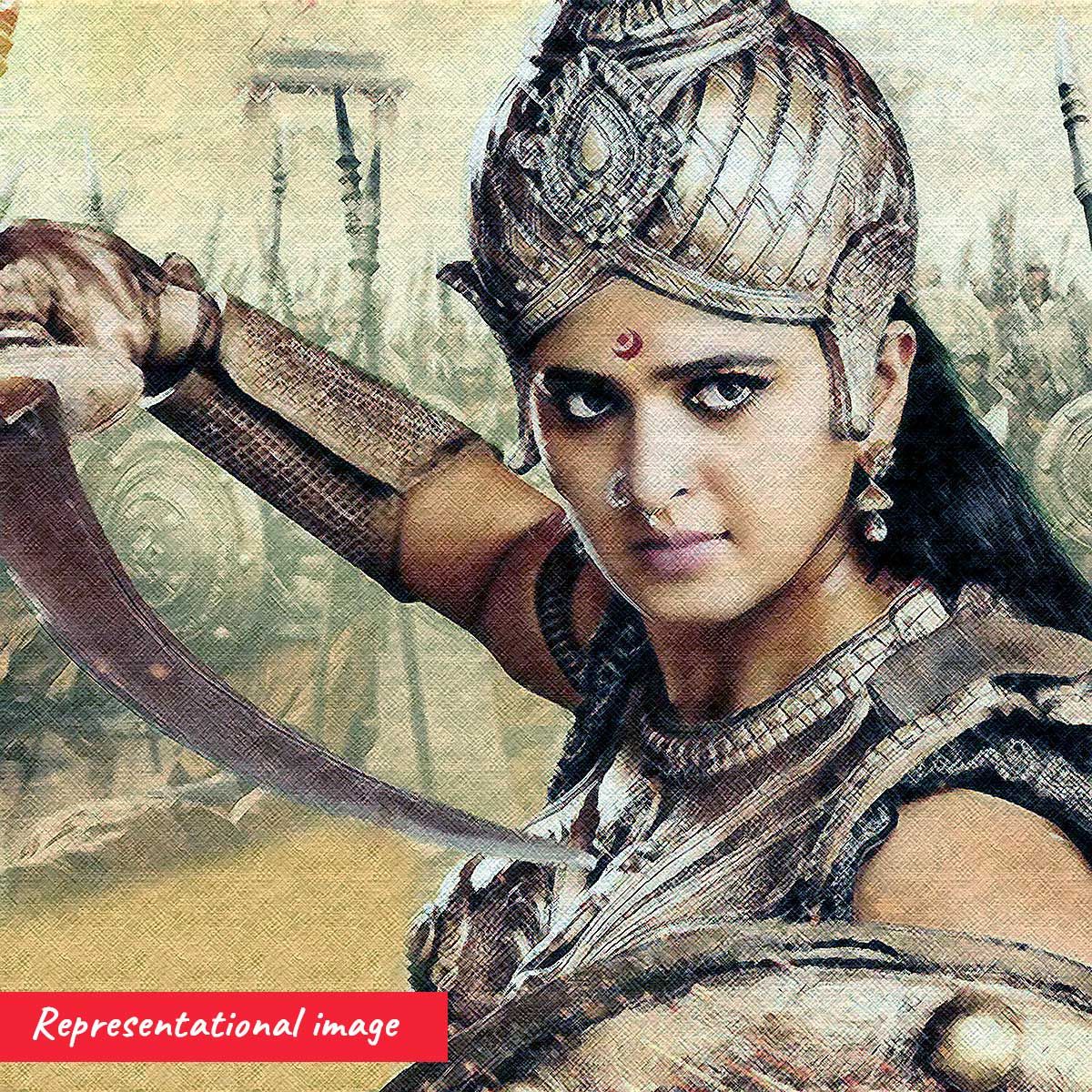
We have all learned and studied about the shrewd and vicious conqueror Timur Lang (Taimur) who ruled from Samarkand city in (Modern day Uzbekistan) his capital and conquered West Asia, India and Central Asia, in our history books. However, our history books do not mention the courageous, fearless, and warrior girl Rampyari Gurjar Chauhan who was just 20 years old when she with other warriors suppressed the Timur’s army and saved their country from a ruthless conqueror.
Rampyari Gurjar! She is an unknown name in Indian History. But her tale of valor is unmatched in the annals of our history books. Like thousands of other warriors who don’t find a place in our historical records, she remains unsung. 20-year old Rampyari Gurjar, along with 40,000 women warriors, wreaked havoc on Taimur in Meerut and Haridwar in 1398, forcing him to flee India. Around 80,000 men from different communities and hill tribes were part of the troop that attacked Taimur and slaughtered a major portion of his army. Meerut, Haridwar and neighboring areas were saved from being looted and plundered by Taimur. They saved the Hindus of the region from being massacred. Taimur Lang had massacred lakhs of Hindus, razed temples to the ground, and looted wealth of temples and civilians on his way from across the Indus River covering Attock towards Delhi. But he couldn’t do this act of barbarism on his return route!
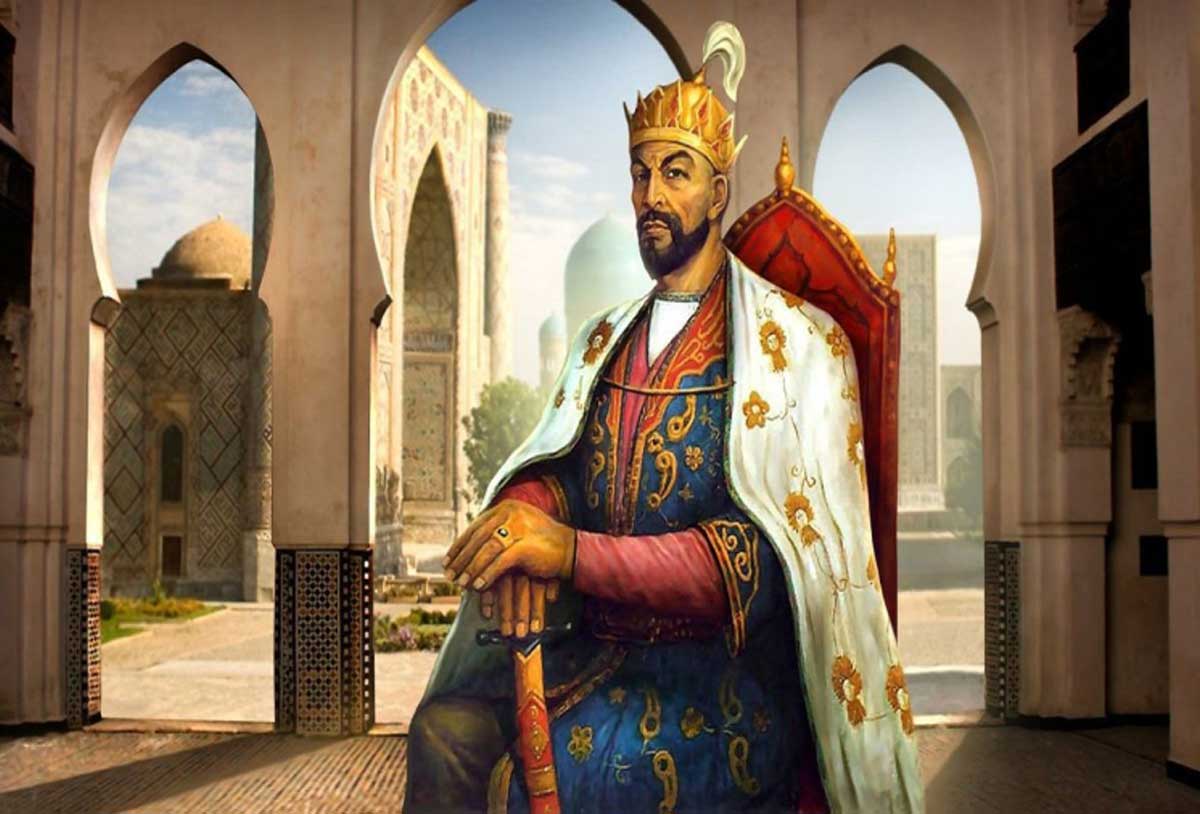 Timur Lang |
Rampyari Gurjar was born in Saharanpur in a Chauhan Gurjar family. During her childhood days, she loved listening to tales of valor of Indian warriors. She dressed up as a male as she grew up and took interests in exercises and wrestling. She was daring and fearless since her childhood. While in the farmland, she would quietly perform the daily exercises. She also practiced the art of warfare all by herself. She watched wrestling matches with great zest. She was known far and wide for her soldierly traits.
Much of the historical records available about the glories and victories of Indian warriors were destroyed by the British. This was to prove their superiority and show the later generations and the world that they were superior and that they civilized India. The Gurjars were very brutal against British. They slaughtered a great number of Britishers. In return, the British declared the Gurjars as a criminal tribe in records and wiped off whatever historical records they could come across about this community. Counted few Britishers left true accounts they saw. Through these accounts, true history of this community and accounts of heroism of other Indian warriors are exposed. Besides, historical ballads and folklores, passed down from one generation to another orally, glorify the warriors. Folklores and ballads in the UP, Haridwar, and Garhwal region glorify Rampyari Gurjar and all those warriors who fought against Taimur.
Most of the available historical records glorify Taimur’s conquest of Delhi. These records don’t mention the barbaric Turco-Mongol conqueror’s failed expedition in Meerut, Haridwar, and the Garhwal region. The Hairdwar-Garhwal episode does find mention in 15th- century Persian historian Sharaf ad-Dīn‘Alī Yazdī’s book Zafarnama , a biography on Taimur. The same is quoted by Muhammad ibn Arabshah, an Arab writer and traveler, in a biography on the Turco- Mongol conqueror.
What actually happened to Taimur that hastened him to flee India without repeating the crimes he committed during his onward journey to Delhi? Historical records describe the barbarism committed by Taimur in Delhi. He had 100,000 Hindu captives by the time he reached Delhi. He executed all of them and created a pillar with the heads. He spared those who converted to Islam. Vincent A Smith in his book The Oxford History of India: From the Earliest Times to the End of 1911 wrote how Taimur’s attack was targeted on the Hindu population. His forces spared only Muslim neighbourhoods and massacred or enslaved the Hindus.
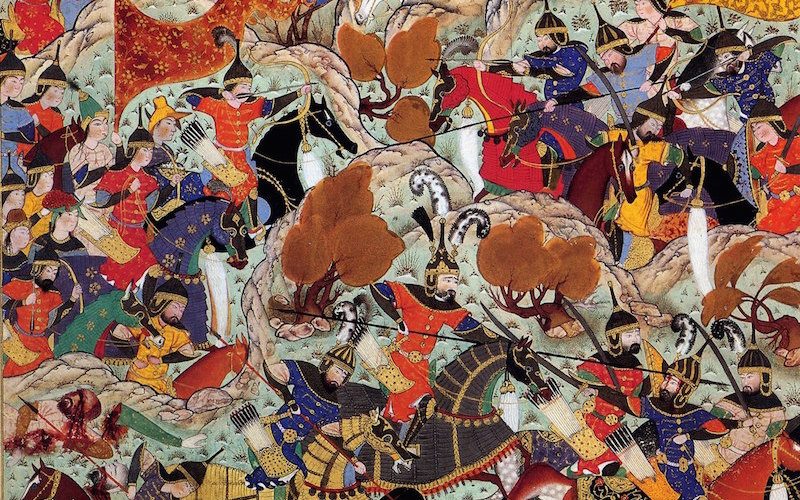 |
Henry Miers Elliot and John Dowson in their book The History of India, as Told by Its Own Historians: The Muhammadan Period. Vol. III finds mention of the following description about Taimur’s barbarism in Delhi, quoted from Sharaf ad-Dīn‘Alī Yazdī’s book Zafarnama: ‘(Timur’s) soldiers grew more eager for plunder and destruction. On that Friday night, there were about 15,000 men in the city who were engaged from early eve till morning in plundering and burning the houses. In many places the impure infidel gabrs (of Delhi) made resistance. (...) Every soldier obtained more than twenty persons as slaves, and some brought as many as fifty or a hundred men, women and children as slaves of the city. The other plunder and spoils were immense, gems and jewels of all sorts, rubies, diamonds, stuffs and fabrics, vases and vessels of gold and silver. (...) On the 19th of the month Old Delhi was thought of, for many Hindus had fled thither. Amir Shah Malik and Ali Sultan Tawachi, with 500 trusty men, proceeded against them, and falling upon them with the sword dispatched them to hell.’
Taimur’s return journey was not by choice, but by compulsion. He was badly defeated in several battles in Meerut and Haridwar. He had to flee with a fatal wound that led to his death later.
During this time, Devpala was the leader in the region comprising today’s Meerut, Saharanpur, parts of Haryana, and Haridwar. The people were alerted of the atrocities and massacre of Hindus committed by Taimur. People of different communities, principally Jats, Gurjars, Ahirs, Valmikis, Rajputs, Brahmins, tribals, and more got united for a common cause — to save the region from being looted and plundered and to save the Hindus from being massacred. Panchayat system was prevalent during this time under Devpala.
A Mahapanchayat was organized in urgency under the instructions of Devpala. It was around the end of 1398 when Taimur was in Delhi. Leaders from adjoining regions attended the Mahapanchayat. It was decided that 500 young horsemen would spy on Taimur to know about his plans and future attacks. That all strong men and women of the region would take up arms, get trained, and join the Mahapanchayat army. That the elders and children would be shifted to safe places and few villages prone to attacks would be vacated.
At this Mahapanchayat, Mahabali Jograj Singh Gurjar was chosen as the Supreme General. Around 80,000 men joined the cause. Several generals were chosen by the panchayat. Among the generals were Mamchand Gurjar, Harbir Singh Gulia Jat, Dhula Valmiki, Durjanpal Ahir, Tuhiram Rajput, Umra Tyagi, Hula Nai, to name a few.
Rampyari Gurjar was made the Commander of the women wing. She was only 20 years old, but was strong and was trained in the art of warfare. She had leadership attributes. She was entrusted to expand her army by requesting more women to join. Other women who were appointed in similar rank were Hardai Jat, Devi Kaur Rajput, Chandro Brahmin, and Ramdai Tyagi. In a short period of time, around 40,000 young village women joined the cause under Rampyari Gurjar. These women never took part in a battle. But to save the motherland, to save the temples, to save the Hindus from being slaughtered, they were ready to sacrifice their lives. She trained the women on the various tactics of using weapons.
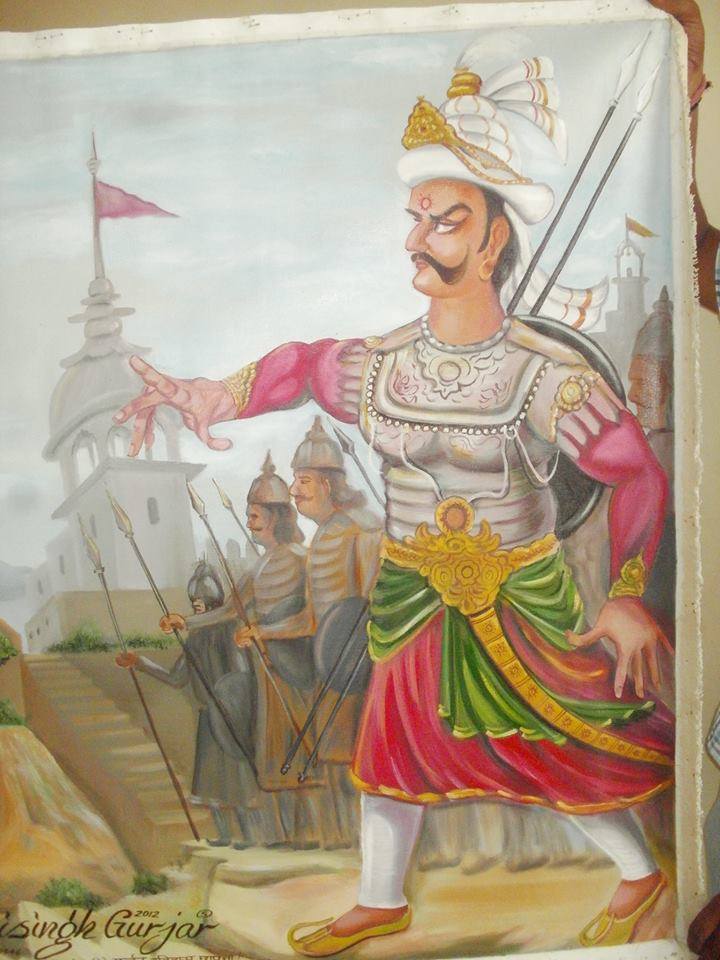 Jograj Singh Gurjar |
Meanwhile, the entrusted spies brought the news that Taimur would be advancing towards Meerut. This meant that he might take the route towards Saharanpur, Haridwar, and Garhwal. All the 80,000 men and 40,000 women warriors assembled to hear from their Supreme General Mahabali Jograj Singh Gurjar. They were armed with swords and chanted war cries. Jograj Singh Gurjar thundered thus:
‘Veeroh, reflect on the discourse given by Shri Krishna to Arjun in the Bhagavad Gita. For us the door to heaven (moksha) has been opened. That moksha, which the Rishi Munis achieve by doing Yoga, the hero warriors achieve by sacrificing their lives on the battlefield. Save the nation, that is — sacrifice yourselves, the world will honor you. You have chosen me leader. To my last breath I will not withdraw. I salute the Panchayat, and take oath that until my last breath I will defend the soil of Bharat. Our nation has been shaken by the crimes and attacks of Taimur. Warriors arise and do not delay. Fight the enemy army and throw them out of the nation.’
Rampyari Gurjar kissed her sword, so did the other women warriors. The men and the women together took an oath that until their last breath they would obey the Supreme General and sacrifice their lives for the motherland. They pledged that they would never let Taimur and his army breathe freely until they were driven out of the country.
For reduced casualties of the Hindu army, it was decided that they would attack Taimur and his army following Guerilla warfare techniques and plan according to information given by the spies. The Guerrilla warfare involved involvement of a small group of combatants in ambushes, hit-and-run tactics, sabotage, raids, etc. using arms. They also decided to face the enemy forces in open battles.
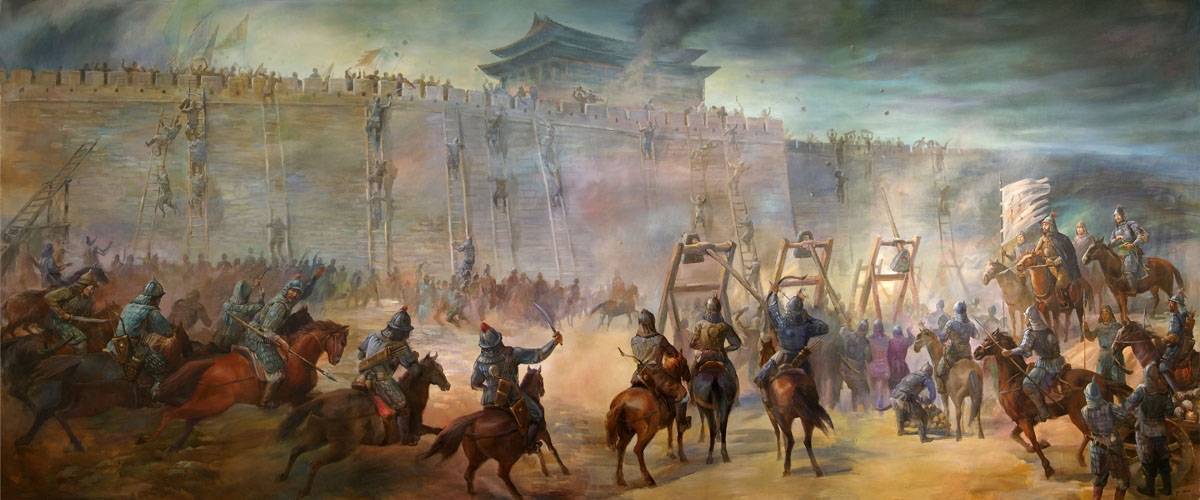 |
Rampyari Gurjar instructed her troops how to act during Taimur’s attack. It was decided that the women would accompany the men. While part of the group of women would take up arms and attack the enemy, few would prepare food for the entire unit. Few would also help deliver war materials to men and women warriors in action. Rampyari Gurjar also entrusted the brave women to attack and loot the supplies of the enemy. This would lead to food shortage of the enemy. Their starvation would only weaken their spirits and the Hindu army could wreak havoc in the enemy lines.
According to an account by Dalip Singh Ahlawat in Jat History, 20,000 Mahapanchayat warriors laid a surprise attack on Taimur’s army in the middle of the night in Delhi. 9,000 of the enemy soldiers were slaughtered and their corpses thrown in river Yamuna. Before daylight, the Mahapanchayat warriors disappeared towards the outskirts of Delhi, far away from Taimur’s forces. This continued for three nights. A frustrated Taimur Lang then left Delhi and advanced towards Meerut.
Taimur Lang’s attempt of plundering Meerut failed. Following the information given by the Panchayat spies, the heavily populated areas in Meerut were emptied and precious belongings shifted to a safe place. Villages enroute to Meerut from Delhi, especially the route taken by Taimur, were also vacated. Hence Taimur and his army felt restless. The Mahapanchayat warriors attacked Taimur’s forces during the day.
At night Rampyari Gurjar and the women warriors laid surprise Guerrilla attacks in the enemy camps, butchering the Mohammedan forces and looting their food supplies. As the enemy soldiers were taken unawares, they could not retaliate fully. Many of them were killed. They remained alert the next night and retaliated. This continued for a couple of days. The Hindu army gave the enemy no chance to take rest or relax even at night. There were casualties from both sides, but it was higher on the enemy side.
 |
Frustrated, Taimur and his forces marched towards Haridwar. The hill tribes, who were experts in archery, joined the Hindu forces. The Mahapanchayat followed the same strategy, as they followed in Meerut. Taimur was defeated thrice in Haridwar. In the last battle, 22 year old Harbir Singh Gulia Jat was able to hit Taimur on his chest with a spear. In retaliation, Taimur’s soldiers badly wounded Harbir. Jograj Singh Gurjar took charge of the situation, at the same time facilitating the wounded Harbir to be taken to a safe place. The wounded Taimur, escorted by one his ablest soldiers, fled the battlefield.
It is said Taimur could not recover fully from this wound. Description about this wound in a Haridwar battle finds mention in one of Taimur’s biographies. He died after 7 years. Taimur had come to India with an army of over 1 and half lakh men. He returned with only a few thousand soldiers. The rest were slain by the Hindu army. Around 40000 Mahapanchayat Hindu warriors, both men and women, attained martyrdom. But they saved the region from being looted and plundered. They saved the Hindus from being massacred.
Salute to Rampyari Gurjar and the Mahapanchayat warriors! Jai Hind!
References:
theprofessionaltimes.com - Akshita Verma
Saffron Swords: Centuries of Indic Resistance to Invaders - Manoshi Sinha Rawal, Yogaditya Singh Rawal
 Support Us
Support Us
Satyagraha was born from the heart of our land, with an undying aim to unveil the true essence of Bharat. It seeks to illuminate the hidden tales of our valiant freedom fighters and the rich chronicles that haven't yet sung their complete melody in the mainstream.
While platforms like NDTV and 'The Wire' effortlessly garner funds under the banner of safeguarding democracy, we at Satyagraha walk a different path. Our strength and resonance come from you. In this journey to weave a stronger Bharat, every little contribution amplifies our voice. Let's come together, contribute as you can, and champion the true spirit of our nation.
 |  |  |
| ICICI Bank of Satyaagrah | Razorpay Bank of Satyaagrah | PayPal Bank of Satyaagrah - For International Payments |
If all above doesn't work, then try the LINK below:
Please share the article on other platforms
DISCLAIMER: The author is solely responsible for the views expressed in this article. The author carries the responsibility for citing and/or licensing of images utilized within the text. The website also frequently uses non-commercial images for representational purposes only in line with the article. We are not responsible for the authenticity of such images. If some images have a copyright issue, we request the person/entity to contact us at This email address is being protected from spambots. You need JavaScript enabled to view it. and we will take the necessary actions to resolve the issue.
Related Articles
- Hero of Pawankhind: Veer Maratha Bajiprabhu Deshpande, who led 300 Soldiers against 12000 Adilshahi Army defending Shivaji
- Assam King Prithu who badly defeated Bakhtiyar Khilji, destroyer of Nalanda University in Battle of Kamrup in 1206 CE
- Jhalkaribai: The Indian Rebellion Of 1857 Who Took on British Forces Disguised as Laxmibai
- Unsung Heroine Pritilata Waddedar, Who Shook The British Raj at the age of 21
- How Britishers were challenged by 83 year old Ropuiliani in Mizoram in 1892-’93
- Kartar Singh Sarabha - The Freedom fighter who was Hanged at the age of 19 and inspired Bhagat Singh
- Our first true war of independence lie forgotten within the fog of time and tomes of propaganda: Sanyasi Rebellion, when "renouncers of the material world" lead peasants in revolt against British and fundamentalist islamic clans
- Saraswathi Rajamani, at 16, became the youngest and first female spy for INA, boldly recruited by Netaji in 1942, courageously spent two years spying on the British in Myanmar during WWII, a pivotal yet overlooked heroine in India's struggle for freedom
- Tirot Singh: An Unsung Hero of the Khasi Tribe who destroyed British with his skill at Guerrilla Warfare
- Dangers of losing our identity: Guru Tegh Bahadur forgotten and Aurangzeb being glorified
- Santi Ghosh and Suniti Choudhury: Two Teenage Freedom Fighters Assassinated British Magistrate
- "Nak-Kati-Rani": Defying Shah Jahan, Rani Karnavati of Garhwal inflicted unprecedented humiliation on the Mughal army, cutting off their noses; her invincible spirit remain unsung in mainstream history, overshadowing the grand tales of emperors
- On 16th Aug 1946, during Ramzan's 18th day, Direct Action Day aimed to provoke Muslims by mirroring Prophet Muhammad's victory at Badr, Gopal 'Patha', the Lion of Bengal, heroically saved Bengali Hindus & Calcutta from a planned genocide, altering history
- A revolutionist freedom fighter who the British Raj framed for murder
- Winston Churchill's hate for Indians caused millions of deaths: A villainous supremacist
























